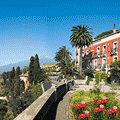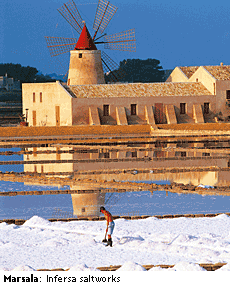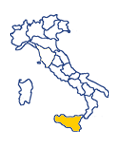The Salt Route: Trapani, Erice and Marsala
This itinerary carries you along the ancient Salt Route, next to the extreme west corner of Sicily, where a fine historical heritage and absolutely unique natural features await the tourist. Come with us to discover why…
Lodging: According to your needs and your budget, you can choose your lodgings from among any number of options, including hotels of every kind, or comfortable bed-and-breakfasts at Trapani, Erice, or Marsala. If you're looking for a unique experience, opt for one of the many agritourism lodgings, or charming and hospitable residence hotels in a real "baglio", or ancient Sicilian farm, immersed in the country or looking out over the sea.
Marsala
Marsala is a gorgeous city of art, rich in Punic, Roman, Norman, Arab, and Spanish heritage. It was founded by the Carthaginians at the beginning of the 4th century B.C. under the name of Lilibeo, but during medieval times, it was conquered by the Arabs, who called it Mars-el-Allah (port of God). The Normans conquered Marsala in 1072, erecting a castle and constructing churches and convents.
The name of the city is connected to the famous wine that has been produced here since the end of the 8th century. An enterprising Englishman, John Woodhouse, established the first wine factory that produced marsala, which went on to have such a large part in the economic fortunes of the city.
The Cathedral (Duomo), constructed by the Normans and largely remodeled in the succeeding centuries. The building face dominates the piazza in Doric style, with 18th century elements like the portal and the displays on the windows.
Behind the Duomo, don’t miss the Tapestry Museum, with 8 beautiful Flemish tapestries from the 16th century, representing scenes from the war of Tito against the Judeans.
On the seafront lies the Regional Archaeological Museum, where visitors can admire Punic findings from the Isle of Mozia and from the necropolises of Lilibeo. In one large room the remains of a Punic nave are preserved, a unique example of this type of nave which was discovered in the Stagnone lagoon.
Continuing along the seafront, down to the easternmost point of the city, we come upon an archeological park containing remains of a Roman city from the 3rd or 4th century B.C.: remains of dwellings, a bathhouse and some lovely polychromatic mosaics.
Another important attraction of Marsala are the historical Florio wine cellars, two centuries old (Lungomare Florio, 1 Marsala +39 0923 781111), where you can observe the production processes of this lovely aromatic wine.
The saltworks
The coast from Marsala to Trapani is characterized by one of the landscapes most peculiar to Sicily: the saltworks. Large mirrors of saltwater form an irregular and multicolored chessboard, where for centuries the precious substance has been produced. In some areas you can see a windmill, which at one time served to pump water and grind the salt.
Among the most beautiful of these are the Saltworks of Trapani and Paceco, which are protected by the World Wildlife Federation for their role as home to around 170 different bird species, including flamingos, storks, cranes, and herons.
The saltworks visitor center can be found at Nubia, just below Trapani on the coastal road SP 21. In a 300-year old salt house, the Museum of Salt was instituted, illustrating the phases of salt production and some of the equipment utilized for its extraction and collection. By night, nature offers most beautiful sunsets in Sicily, with colors that shift from red to orange to pink, encircling the ancient mills and the silhouettes of the Egadi Islands.
Trapani
Trapani, of winding design and baroque architecture in bright stone, extends out into the sea in its characteristic shape of a scythe, with the majestic Tower of Ligny rising from its extreme point. Under Arab dominion, Trapani was a flowering center for the production of salt, tuna, and coral. In the 16th century, Trapanese coral artisans made the city famous throughout the Old World. A gorgeous collection of works in coral is preserved in the Pepoli Museum.
Corso Vittorio Emanuele, the main street of the old city, is flanked by baroque churches and buildings:
- The Jesuit Church of Collegio, from the 17th century, has a wonderful baroque facade of great relief moldings. Inside there are three naves, with some notable 18th-century altars of mixed marble and, in the main altar, a bas-relief by Marabiti, representing Maria Immacolata.
- The Cathedral, constructed in the 17th century, guards within it some funerary monuments and a crucifix, which some attribute to Anthony Van Dyck.
In the ancient Jewish quarter, along Via Giudecca, it is worth the trouble to stop in front of the Giudecca Palazzo, from the 16th century, constructed in the Spanish plateresque style.
The Sanctuary of Annunziata is an original church from the 15th century, with rose window and portal from the 1400s, the belltower from 1650. Inside it contains beautiful chapels, rich in masterpieces. The most celebrated and lovely chapel is the Chapel of the Madonna. On the main altar there is a statue of the Virgin: the Madonna of Trapani, by Nino Pisano, extremely venerated by the Trapanese. It is a true and inimitable masterpiece of sculpture.
The former convent of the Annunciation hosts the Pepoli National Museum which, for the richness and variety of its collections, is considered one of the most important museums in Sicily, and worth a visit just for its striking ambiance. The first floor hosts the picture gallery, which collects many precious paintings, including a Pietà masterpiece by Roberto Oderisio from 1380. Don't miss the artistic creations in coral (necklaces, sacred furnishings and nativity figurines), which bear witness to the artistic quality achieved by the artisans of Trapani.
The procession of the Mysteries: of exceptional power is the procession of the Saint Friday, when the Mysteries, ancient wooden statues that represent scenes from the Passion of Christ, are carried on the shoulders in an imposing procession that covers, for 24 consecutive hours, the streets of the historical center, while from the balconies, onlookers throw down flower petals.
Erice
It is the best-known city of this edge of Sicily, and with good reason. Located in a panoramic position 750 feet above sea level, Erice preserves whole all the fascination of an ancient medieval village, with little piazzas, winding streets, gorgeous flowering courtyards and more than 60 small churches.
The view from here can span over all of eastern Sicily, over Trapani, Marsala, and the Egadi Islands.
Erice was founded in the 7th century b.C. by the Elymians, who erected the temple dedicated to the worship of their fertility goddess. Afterward, the Greek worshipped Aphrodite and Roman Venus. On the ruins of the Temple stands today the Castle of Venus, from the Norman times.
The historical center is surrounded by Cyclopian walls of Punic origin (6th century b.C.). The Normans opened up three ports (Trapani, Carmine, and Spada). Entering through the port of Trapani, one comes upon the Duomo (cathedral), erected in the 14th century in Gothic style. The isolated belltower served also as a lookout tower for defense of the city. The inside was rebuilt in the 19th century in Neogothic style.
Southeast of the inhabited areas, above an elusive rock from where the Temple of Venus arises, the Normans erected the grandiose Castle of Venus, an impregnable fortress in defense of the city, sometime between the 12th and 14th centuries. Some towers and walls still remain from this castle. To the left of the Norman castle rises the Castle of Balio (the governor), constructed by Count Pepoli in the 1800's and the medieval Norman towers, restored by the Count during the same period.
Every summer Erice hosts the famous Week of Medieval and Renaissance Music, which attracts internationally famous artists and a great many fans.
Go to directories of the Web Sites
Photos are courtesy of: AAPIT Agrigento and APT Trapani
|





